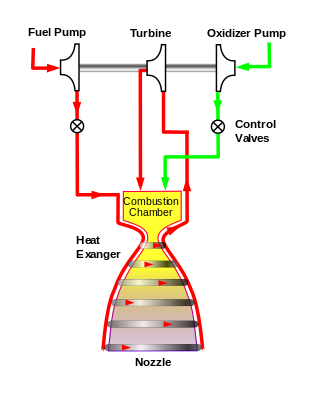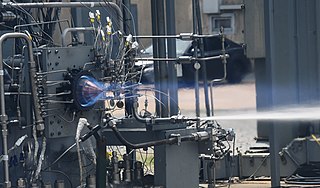| Country of origin | United States New Zealand |
|---|---|
| Designer | Rocket Lab |
| Manufacturer | Rocket Lab |
| Application | First- and second-stage engine [1] |
| Status | In development |
| Liquid-fuel engine | |
| Propellant | LOX / liquid methane [1] |
| Cycle | ORSC [2] [3] |
| Configuration | |
| Chamber | 1 |
| Performance | |
| Thrust, vacuum | 200,000 lbf (890 kN) (Vacuum version) [2] |
| Thrust, sea-level | 165,000 lbf (730 kN) [2] |
| Throttle range | 100% - 50% |
| Specific impulse, vacuum | 329s (SL) 365s (Vac version) [2] |
| Burn time | multiple [3] |
| Used in | |
| Neutron | |
| References | |
| References | [2] [3] |
Archimedes is a liquid-fuel rocket engine burning liquid oxygen and liquid methane in an oxidizer-rich staged combustion cycle. [2] [3] It is designed by aerospace company Rocket Lab for its Neutron rocket. [1] [2]
Archimedes was presented on December 2, 2021, in a webcast by Rocket Lab CEO Peter Beck. [4] It was presented as a fully reusable, gas generator engine using LOX and methane as propellant, a departure from the company's previous Rutherford, which is electrically pump fed. He then stated that it had a thrust of 1 MN (220,000 lbf) and 320 seconds of specific impulse. The same day, the Neutron page on Rocket Lab's website was updated specifying the thrust of the seven Archimedes used on the first stage as 5,960 kN (1,340,000 lbf) at sea level and a maximum thrust of 7,530 kN (1,690,000 lbf) and the upper stage's single vacuum optimized Archimedes at 1,110 kN (250,000 lbf). It is expected to have its first hot-fire test during May, 2024. [5]
In an interview published on CNBC website, Mr. Beck stated that Archimedes would be manufactured in New Zealand and its very simple design had "all the things you want when you have to build an engine that can be reused over and over again.” [6] In the September 21st, 2022 Investor Day Presentation, the engine design had changed to an oxidizer-rich staged combustion cycle. [2] The presentation stated that the sea level version would have a maximum thrust of 730 kN (160,000 lbf) with an isp of 329s and would be able to throttle to a 50% of maximum thrust.
Meanwhile, the vacuum optimized version, would have a maximum thrust of 890 kN (200,000 lbf), an isp of 367s and the same throttling capabilities of 50% of maximum thrust. [2] [3] It was also implied, but not confirmed, that the engine would be built in the Virginia, USA factory. It was disclosed they would use the Stennis Space Center A-3 Test stand for development testing. They expected to start preburner testing in that or following quarter, hopefully starting full engine testing at Stennis before 2023 ends, and hoped to be able to launch by mid 2025.
Archimedes is presented as a highly reusable liquid-propellant engine using methane and liquid oxygen in an oxidizer-rich staged combustion cycle. [2] [3] There are both sea-level and vacuum variants. The engine is mostly 3D printed, [7] with some of the biggest 3D printers in the world. The rationale for the cycle change from the original gas generator was that they could not get the performance they needed through all the throttle points that a reusable rocket needs, without pushing the turbine temperature and other factors beyond their preset limits. By changing to the higher performing cycle but with lower performance requirements, they were able to lower temperatures and other stress factors and increase margins everywhere, making reusability much more attainable. [3]

A hybrid-propellant rocket is a rocket with a rocket motor that uses rocket propellants in two different phases: one solid and the other either gas or liquid. The hybrid rocket concept can be traced back to the early 1930s.

The expander cycle is a power cycle of a bipropellant rocket engine. In this cycle, the fuel is used to cool the engine's combustion chamber, picking up heat and changing phase. The now heated and gaseous fuel then powers the turbine that drives the engine's fuel and oxidizer pumps before being injected into the combustion chamber and burned.

A liquid-propellant rocket or liquid rocket utilizes a rocket engine burning liquid propellants. (Alternate approaches use gaseous or solid propellants.) Liquids are desirable propellants because they have reasonably high density and their combustion products have high specific impulse (Isp). This allows the volume of the propellant tanks to be relatively low.

The Aerojet Rocketdyne RS-25, also known as the Space Shuttle Main Engine (SSME), is a liquid-fuel cryogenic rocket engine that was used on NASA's Space Shuttle and is used on the Space Launch System (SLS).

The John C. Stennis Space Center (SSC) is a NASA rocket testing facility in Hancock County, Mississippi, United States, on the banks of the Pearl River at the Mississippi–Louisiana border. As of 2012, it is NASA's largest rocket engine test facility. There are over 50 local, state, national, international, private, and public companies and agencies using SSC for their rocket testing facilities.

The J-2, commonly known as Rocketdyne J-2, was a liquid-fuel cryogenic rocket engine used on NASA's Saturn IB and Saturn V launch vehicles. Built in the United States by Rocketdyne, the J-2 burned cryogenic liquid hydrogen (LH2) and liquid oxygen (LOX) propellants, with each engine producing 1,033.1 kN (232,250 lbf) of thrust in vacuum. The engine's preliminary design dates back to recommendations of the 1959 Silverstein Committee. Rocketdyne won approval to develop the J-2 in June 1960 and the first flight, AS-201, occurred on 26 February 1966. The J-2 underwent several minor upgrades over its operational history to improve the engine's performance, with two major upgrade programs, the de Laval nozzle-type J-2S and aerospike-type J-2T, which were cancelled after the conclusion of the Apollo program.

Merlin is a family of rocket engines developed by SpaceX for use on its Falcon 1, Falcon 9 and Falcon Heavy launch vehicles. Merlin engines use RP-1 and liquid oxygen as rocket propellants in a gas-generator power cycle. The Merlin engine was originally designed for sea recovery and reuse, but since 2016 the entire Falcon 9 booster is recovered for reuse by landing vertically on a landing pad using one of its nine Merlin engines.

The Space Launch Initiative (SLI) was a NASA and U.S. Department of Defense joint research and technology project to determine the requirements to meet all the nation's hypersonics, space launch and space technology needs. It was also known as the second generation Reusable Launch Vehicle program, after the failure of the first. The program began with the award of RLV study contracts in 2000.

The LE-7 and its succeeding upgrade model the LE-7A are staged combustion cycle LH2/LOX liquid rocket engines produced in Japan for the H-II series of launch vehicles. Design and production work was all done domestically in Japan, the first major (main/first-stage) liquid rocket engine with that claim, in a collaborative effort from the National Space Development Agency (NASDA), Aerospace Engineering Laboratory (NAL), Mitsubishi Heavy Industries, and Ishikawajima-Harima. NASDA and NAL have since been integrated into JAXA. However, a large part of the work was contracted to Mitsubishi, with Ishikawajima-Harima providing turbomachinery, and the engine is often referred to as the Mitsubishi LE-7(A).

The pintle injector is a type of propellant injector for a bipropellant rocket engine. Like any other injector, its purpose is to ensure appropriate flow rate and intermixing of the propellants as they are forcibly injected under high pressure into the combustion chamber, so that an efficient and controlled combustion process can happen.
The RD-701 is a liquid-fuel rocket engine developed by Energomash, Russia. It was briefly proposed to propel the reusable MAKS space plane, but the project was cancelled shortly before the end of USSR. The RD-701 is a tripropellant engine that uses a staged combustion cycle with afterburning of oxidizer-rich hot turbine gas. The RD-701 has two modes. Mode 1 uses three components: LOX as an oxidizer and a fuel mixture of RP-1 / LH2 which is used in the lower atmosphere. Mode 2 also uses LOX, with LH2 as fuel in vacuum where atmospheric influence is negligible.
Fastrac was a turbo pump-fed, liquid rocket engine. The engine was designed by NASA as part of the low cost X-34 Reusable Launch Vehicle (RLV) and as part of the Low Cost Booster Technology project. This engine was later known as the MC-1 engine when it was merged into the X-34 project.

Rocket propellant is the reaction mass of a rocket. This reaction mass is ejected at the highest achievable velocity from a rocket engine to produce thrust. The energy required can either come from the propellants themselves, as with a chemical rocket, or from an external source, as with ion engines.

Since the founding of SpaceX in 2002, the company has developed four families of rocket engines — Merlin, Kestrel, Draco and SuperDraco — and is currently developing another rocket engine: Raptor, and after 2020, a new line of methalox thrusters.
The BE-3 (Blue Engine 3) is a LH2/LOX rocket engine developed by Blue Origin.

The Blue Engine 4 (BE-4) is an oxygen-rich liquefied-methane-fueled staged-combustion rocket engine produced by Blue Origin. The BE-4 was developed with private and public funding. The engine has been designed to produce 2.4 meganewtons (550,000 lbf) of thrust at sea level.

A rotating detonation engine (RDE) uses a form of pressure gain combustion, where one or more detonations continuously travel around an annular channel. Computational simulations and experimental results have shown that the RDE has potential in transport and other applications.

Rutherford is a liquid-propellant rocket engine designed by aerospace company Rocket Lab and manufactured in Long Beach, California. The engine is used on the company's own rocket, Electron. It uses LOX and RP-1 as its propellants and is the first flight-ready engine to use the electric-pump feed cycle. The rocket uses a similar engine arrangement to the Falcon 9; a two-stage rocket using a cluster of nine identical engines on the first stage, and one vacuum-optimized version with a longer nozzle on the second stage. This arrangement is also known as an octaweb. The sea-level version produces 24.9 kN (5,600 lbf) of thrust and has a specific impulse of 311 s (3.05 km/s), while the vacuum optimized-version produces 25.8 kN (5,800 lbf) of thrust and has a specific impulse of 343 s (3.36 km/s).

Raptor is a family of rocket engines developed and manufactured by SpaceX. The engine is a full-flow staged combustion cycle (FFSC) engine powered by cryogenic liquid methane and liquid oxygen ("methalox").
Neutron is a medium-lift two-stage launch vehicle under development by Rocket Lab. Announced on 1 March 2021, the vehicle is being designed to be capable of delivering a payload of 13,000 kg (28,700 lb) to low Earth orbit in a partially reusable configuration, and will focus on the growing megaconstellation satellite delivery market. The vehicle is expected to be operational sometime in 2025.It uses LOX and liquid methane propellant on both stages of the vehicle.